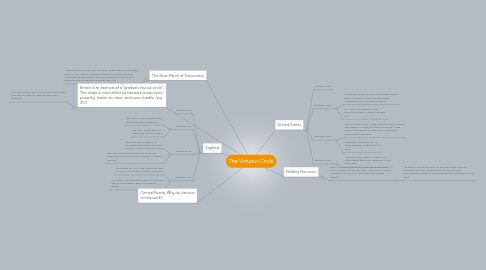
1. Britain is an example of a "gradual virtuous circle". This made it more effective because it was more powerful, harder to resist, and more durable. (pg. 317)
1.1. The elite allowed reforms because they knew it was the only way for them to keep their positions
2. England
2.1. The Black Act
2.2. The Black Act
2.2.1. the "blacks" caused destruction throughout the country side
2.2.2. key note: Parliament was becoming more pluralistic
2.3. The Black Act
2.3.1. "Blacking" was a reaction to the Whigs exploitation of power
2.3.2. May 1723, Parliament passed the Black Act which made the offenses punishable to hanging (pg 494)
2.4. The Black Act
2.4.1. November 10, 1724 John Huntridge was accused of blacking but found innocent
2.4.2. This victory established the Rule of Law: the laws and constraints apply to everyone equally
3. Central Puzzle: Why do virtuous circles work?
4. The Slow March of Democracy
4.1. "The British democracy was not given by the elite. It was largely taken by the masses, who were empowered by the political processes that had been ongoing in England and the rest of Britain for the last several centuries (pg. 310)
5. United States
5.1. Busting Trusts
5.2. Busting Trusts
5.2.1. At the end of the Civil War, the Robber Barons began building monopolies and wealth inequality began to increase rapidly
5.2.2. Ex: John D. Rockefeller, John Pierpont Morgan, Andrew Carnegie, etc.
5.3. Busting Trusts
5.3.1. The pluralistic set up of the political system allowed the masses to stand up to the monopolies. They formed the Populist and then the Progressive movements took place
5.3.2. Interstate Commerce Act of 1887, Sherman Antitrust Act of 1890
5.4. Busting Trusts
5.4.1. The free media played a large role in empowering the broad segments of the population
6. Packing the court
6.1. During the Great Depression, FDR proposed many policies known as the New Deal. The Supreme Court sometimes stood in the way of his acts getting passed
6.1.1. He tried to fix this situation by presenting the Judiciary Reorganization Bill, which would remove the more conservative justices that had persistently opposed the New Deal
